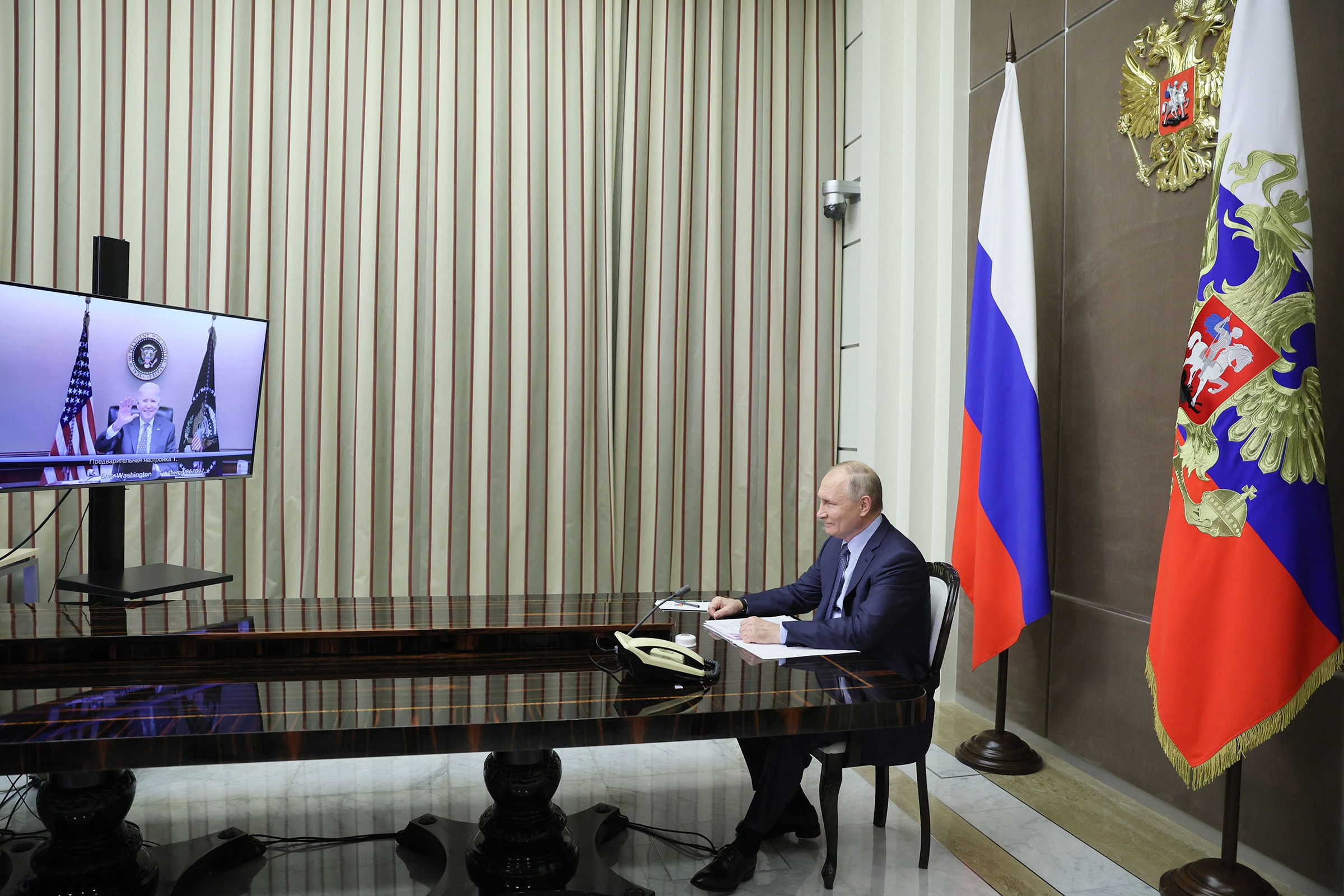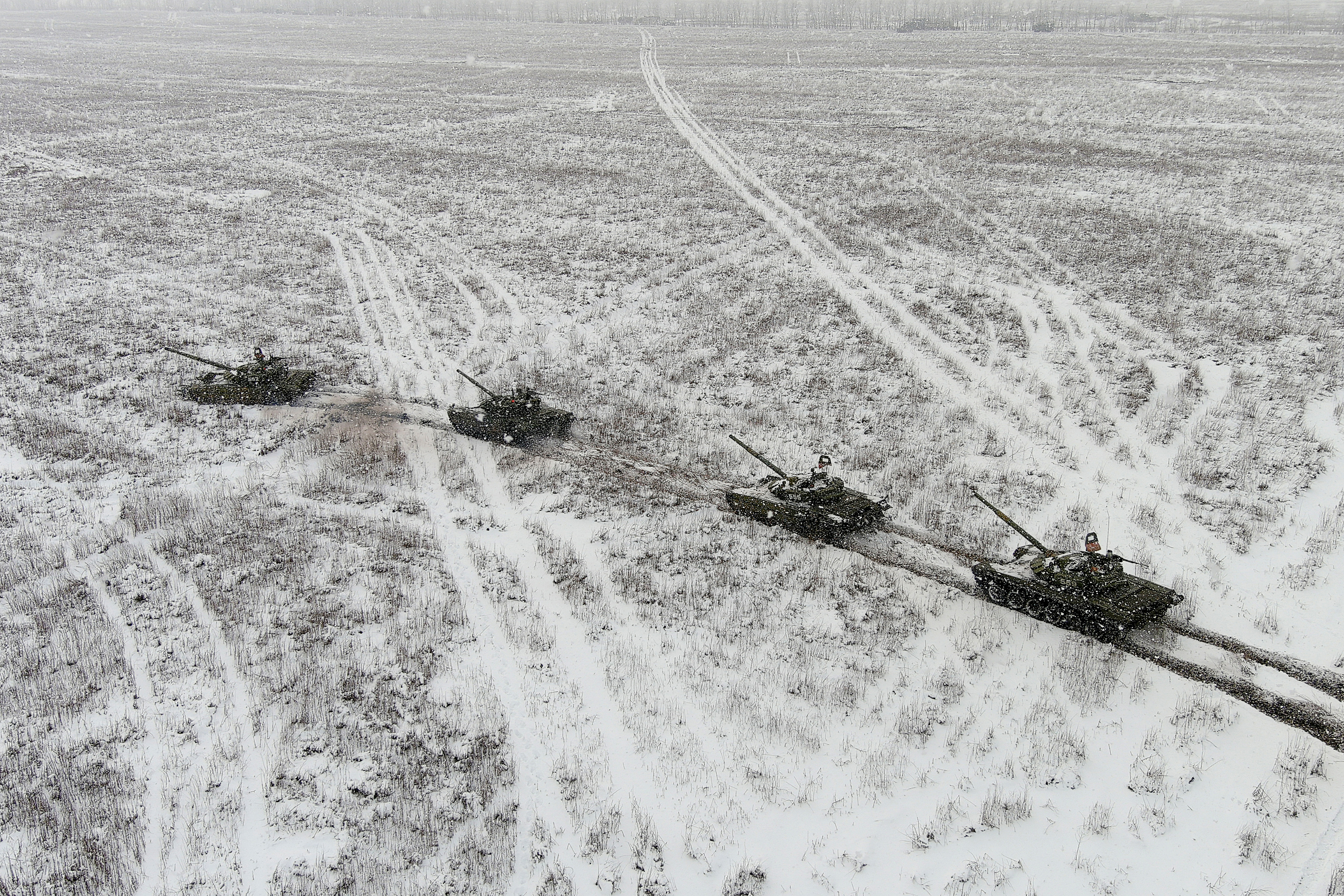
As Russian tanks amassed along the frozen marshes of the Belarus border with Ukraine on Jan. 25, Joe Biden stepped into a small Capitol Hill boutique. After buying a card for First Lady Jill Biden that read “Aaaagh, I miss your face,” a hoodie inked with the constellation Ursa Major, and a mug decorated with a drawing of Vice President Kamala Harris, Biden told reporters that if Russian forces entered Ukraine, it would “change the world.” He would consider issuing personal sanctions against Russian President Vladimir Putin, he said.
The day before, Biden had put 8,500 U.S. troops on high alert for possible deployment, and the North Atlantic Treaty Organization (NATO) moved additional fighter jets and naval ships toward Eastern Europe. “I have made it clear early on to President Putin that if he were to move into Ukraine, that there’d be severe consequences,” Biden said.
But in many ways, the situation has resulted in the opposite: Putin’s gamesmanship has exacted damaging consequences on the United States and the Biden Administration. Putin wants to assert Russia’s relevance on the world stage, embarrass Biden, and test the unity of NATO countries. He’s already well on his way to achieving those ends. Putin has successfully dragged Biden into having to respond to a frustrating series of escalations, complicating the U.S. response to Russia’s actions, distracting from other diplomatic priorities, and upping the political stakes for Biden. His approval ratings sagged after a turbulent withdrawal from Afghanistan last summer led the Taliban to take control of the country, and this represents Biden’s second major foreign policy test as President.
Putin’s gamble is paying off—at least in the short term. “He’s back in the center of attention,” says Charles Kupchan, a professor of international affairs at Georgetown University and former director of European affairs on President Bill Clinton’s National Security Council. “Putin craves being at the table and profoundly laments the Soviet Union’s dismantlement and Russia’s fall from grace.”
Putin now has the world’s attention. On Wednesday, the U.S. and NATO handed formal written responses to Russia’s list of demands that Western forces withdraw from Eastern Europe and disallow any other former Soviet-bloc nations, like Ukraine, from joining the alliance. Secretary of State Antony Blinken cautioned NATO would not close its “open-door” policy to new members but said there was room for negotiation in other areas. “Whether they choose the path of diplomacy and dialogue, whether they decide to renew aggression against Ukraine,” he said, “we’re prepared either way.”
Russian troops, tanks and artillery now surround Ukraine on all sides: in Belarus to the north, Russia to the east, Crimea to the south and Moldova to the west. “Given the type of forces that are arrayed: the ground-maneuver forces, the artillery, ballistic missiles, the air forces, all of it packaged together, if that was unleashed on Ukraine, it would be significant,” General Mark Milley, chairman of the Joint Chiefs of Staff, said Friday at the Pentagon. “And you can imagine what that might look like in dense urban areas, all along roads, and so on and so forth. It would be horrific.”
As the forces continue to build, the State Department ordered nonessential staff and family members to leave the U.S. embassy this week from Ukraine’s capital, Kyiv, out of “an abundance of caution.” Biden, meanwhile, is considering moving thousands of troops as well as naval ships and warplanes into the Baltics and eastern Europe. He spoke to Ukrainian President Volodymyr Zelensky on Thursday and “reaffirmed” that the U.S. would “respond decisively” if Russia invades, according to a readout of the call provided by the White House.
The standoff is proving a major challenge for Biden, as each side escalates by inches. So far Putin has played his hand to his advantage. Putin has “shown that he is still very relevant in geopolitical terms,” says Matt Pottinger, who was President Donald Trump’s deputy national security advisor. “He’s amassed leverage to extract concessions that Russians have wanted since soon after the close of the Cold War 30 years ago.”

Confusing signals from the White House
Putin’s provocations have so far been met with an uneven performance from the White House.
Biden and his aides spent days cleaning up Biden’s confusing responses during his Jan. 19 White House press conference in which he said if Putin launches a “minor incursion” the U.S. and allies will “end up having a fight about what to do and not do.” The next day, Biden tried to clarify that “any assembled Russian units” moving across the Ukrainian border would be considered “an invasion” and there would be a “severe and coordinated economic response.”
Putin’s show of force comes at a time when Biden’s foreign policy apparatus wants to focus on countering China’s growing influence in the Pacific. While much of the world’s attention was focused on the crisis in Ukraine on Sunday, China flew a large formation of warplanes toward Taiwan. “The White House, they want to focus on China, because they correctly see that as the big strategic challenge for the next three or four decades, and they were sort of hoping that Russia would remain quiet. Well, Russia didn’t accommodate,” says Steven Pifer, U.S. ambassador to Ukraine from 1998 to 2000.
Biden had been avoiding U.S. military-involvement in Ukraine, wary of stoking tensions. The lack of diplomatic progress with Moscow in recent weeks, however, has made the president reevaluate his options, Administration officials say. Biden’s decision Monday to alert troops from the Army’s 82nd Airborne Division, 101st Airborne Division, and other units mean that U.S. forces could soon flow into former Soviet bloc nations, such as Estonia, Latvia, and Lithuania, which are now NATO member states.
Placing troop reinforcements in those alliance nations would aim to reassure allies and prevent wider war from consuming the region, defense officials say. “We’re still very much in active discussions with allies and partners about what the needs are,” Pentagon spokesman John Kirby said Tuesday. “Nobody is moving outside the United States at this time. This was just about being ready.” NATO announced this week it had already mobilized additional ships and fighter jets to eastern Europe, while putting ground forces on standby.
The military moves risk sparking conflict on the European continent, which would be costly, bloody, and require extensive U.S. involvement. But Pifer thinks Putin’s trap could backfire in the long term, and may end up energizing the NATO alliance. “If it is a trap, I’m not sure it is working to the Russians’ advantage,” Pifer says. “NATO is more unified than the Russians would have liked. I think this is going to galvanize NATO.”

Putin’s “gray zone” tactics
Putin has tried to use the deployment of more than 100,000 Russian troops along Ukraine’s borders as leverage against the U.S. and its allies to reduce troops, weapons, and influence along his borders.
Putin denies Russia intends to attack Ukraine, but he has made clear that NATO military support for neighboring countries constitutes a growing threat. Last month, the Russian Foreign Ministry published two lengthy draft treaties that listed what Moscow wants from the U.S. and its allies. Russia is effectively seeking to erase the past 31 years since the Soviet Union’s collapse, which handed the U.S. several allies on the Kremlin’s doorstep. The draft treaties call for an end to NATO’s eastward expansion and the U.S. military’s ties with Ukraine and other former Soviet nations—concessions the U.S. has already dismissed as “non-starters.”
Putin may say he has no plans to invade, but his words provide little assurance to U.S. and NATO officials, who watched as Russian forces invaded Georgia in 2008 and Ukraine six years later. Russia annexed Crimea from Ukraine in 2014 and has supported separatist militias in several eastern Ukrainian cities ever since. Those aggressive moves by Russia followed signals from those countries that they were moving farther from Moscow’s sphere of influence.
In recent years, Russia has honed the use of hostile “gray zone” tactics like this, rather than overt conventional military action, to keep adversaries off-balance. Russia employs paramilitary forces, cyber-attacks and disinformation campaigns on nearly every continent to challenge Western security and stability. The Russian buildup in Ukraine is just the latest attempt to undermine NATO unity.
Putin’s tactics can be effective. Tensions with Russia have exposed fissures within the 30-member NATO alliance on developing a strategy to assist Ukraine. Because Ukraine is not a NATO member, the alliance does not share treaty obligations with the government in Kyiv. Each nation has its own interests in relation to Moscow, which has caused diverging opinions in recent weeks on how to best lend support. Germany refused to allow lethal weapons that originated within its borders to be shipped from Estonia to Kyiv to support Ukrainian defenses; the U.S., meanwhile, authorized Baltic nations to provide anti-tank missiles, anti-aircraft missiles, and other equipment to bolster Ukraine’s defenses.
All of which underscores “the importance of marshaling allies around a shared framework for sanctions, export controls, and other economic leverage to deter adversaries from invading their neighbors,” says Pottinger. But some experts worry Biden isn’t leading the NATO alliance with a firm enough stance. While Biden has made promises of sweeping economic sanctions and added military support to Ukrainian forces should Moscow authorize an invasion, his Administration’s threats have lacked specificity, says Ryan Crocker, a retired diplomat who served as ambassador in Lebanon, Kuwait, Syria, Pakistan, Iraq and Afghanistan over his 37-year career. “I’m really concerned that I’m not seeing a concrete expression of what happens to Russia if they go in,” he says, adding that NATO has also failed to articulate the costs it plans to impose. “NATO doesn’t run by itself. We either lead the Atlantic Alliance, or the Atlantic Alliance probably isn’t going to get much done.”
Crocker believes Biden’s mishandling of the withdrawal from Afghanistan caught the attention of adversaries like Russia and China. Following his decision to abruptly pull out of America’s longest war, Biden failed to closely consult and coordinate with Western partners, essentially leaving them to scamper for the exits, Crocker said. “The whole world saw what happened,” Crocker says. “He’s got to show that he can do a whole lot better on another major international issue than he did on Afghanistan.”
More Must-Reads From TIME
- The 100 Most Influential People of 2024
- The Revolution of Yulia Navalnaya
- 6 Compliments That Land Every Time
- What's the Deal With the Bitcoin Halving?
- If You're Dating Right Now , You're Brave: Column
- The AI That Could Heal a Divided Internet
- Fallout Is a Brilliant Model for the Future of Video Game Adaptations
- Want Weekly Recs on What to Watch, Read, and More? Sign Up for Worth Your Time
Write to W.J. Hennigan at william.hennigan@time.com